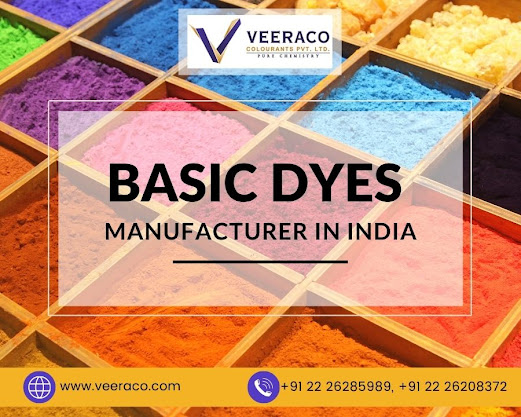The most significant colourants used to add colour or alter colour are dyes and pigments. The textile, pharmaceutical, food, cosmetic, plastic, paint, ink, photography, and paper industries all utilise them extensively. The relative solubility of dyes and pigments differs; although pigments are basically insoluble in the liquid media in which they are disseminated, dyes are soluble. Before comparing different dyes and pigments, it is important to understand their fundamentals and the qualifications needed to work as a dye or pigment.
What does dye or dyestuff mean?
Organic chemicals that are soluble and colourful called dyes are typically sprayed on fabrics after being dissolved in water. They are made with the intention of forming a dependable bond with the polymer molecules that make up the textile fibre. At various points during the textile manufacturing process, several classes of dye are applied to various types of fibre. The textile business uses a wide variety of dyeing procedures. Typically, consumers of dyes get their products from merchants who sell those products or from top dyes manufacturers in India
The fabrics are coloured with dyes. To give human eyes the perception of colour, dyes are chemicals that absorb and reflect light at specific wavelengths. Natural and synthetic dyes are the two main categories of dyes. Natural colours are intricate concoctions of elements originating from organic materials like plants, animals, or minerals. In a lab, synthetic dyes are created. To create synthetic dyes, chemicals are created. Additionally, some synthetic colours contain metals. During the dyeing process, not all of the dyes are bonded to the fibre.
What a True Dye Must Have?
Dyes are not the only colourful compounds. But a real dye must have the following characteristics:
A consistent colour is required.
It should not easily undergo structural changes, have a pleasing hue, and have a durable finish.
It needs to have the capacity to either fix on or attach to material made of solution. For instance, azobenzene is coloured yet unable to adhere to a surface. Azobenzene is not a dye as a result. A dye might also not be able to colour all kinds of substrates. For instance, cotton cannot be permanently dyed yellow with picric acid, while silk or wool can. As a result, a dye can either develop a chemical union or a close physical union with the substrate being dyed.
It must be water-soluble or create a stable and effective dispersion in water. It also needs to be soluble in a substance other than water. It should be kept in mind, nevertheless, that the dye should be picked up well from the medium.
The dye-subject material must naturally bind to the chosen dye and be able to absorb it from a solution or aqueous dispersion. if auxiliary ingredients are required, in the presence of proper concentration, temperature, and pH conditions.
whenever a dye is anchored to a surface. To wash, dry clean, sweat, light, heat, and other organisations must come first. Water, acids, and alkalis must not be able to damage it. Due to the alkaline nature of washing soda and washing soap, in particular the latter. There is probably no dye that can be assured won't change shade in any situation.
Due to various interactions between the molecular orbitals of the dye and the substrate, as well as the ease with which the dye can release the energy it has absorbed into its surroundings without self-decomposition, a given dye's colour and fastness may vary depending on the substrate.
The fixed dye must possess fastness characteristics, such as
Sensitivity to light,
Speed of temperature change,
Water, diluted acids, alkalis, different organic solvents, and soap solution resistance
What exactly is a pigment?
Pigments are insoluble substances used in paints, printing inks, ceramics, and polymers. They are applied by dispersion in an appropriate media. The majority of utilised colours are organic substances. Due to their exceptional light fastness, pigments are frequently used to colour fabrics like cotton, wool, and other man-made fibres. They are attached to the cloth with the aid of resins despite having no attraction for fibres. The cloths are heated up after being dyed. Compared to inorganic pigments, organic pigments generally have a lesser hiding power but a higher tinting strength. Consumers of pigments get their products from merchants who sell those products or from dyes and pigments manufacturers in India.
Pigment requirements:
Sensitivity to light:
Fastness to light, which depends on the medium in which the pigments are disseminated, is the most significant criterion by which pigments are assessed. Pigments generally react to light more slowly in light tints than in dark tints.
Rapidity to Heat:
A pigment should withstand temperatures that are not too high. This is especially true for thermosetting colours and surface coatings that have been heated until they have "cured" or polymerized. Poorer pigments may suffer chemical disintegration as a result of heat treatment or physical transition from one modification to another, losing colour and other qualities.
A solvent's insolubility
In all media, a pigment should not dissolve. However, this requirement is not entirely met. The pigment may crystallise as a result of solubility in the medium or solvent, changing the paint's ability to retain its colour.
Acid's rapidity:
When used in acidic media or when exposed to acid vapours, pigments must be acid-fast.
The rapidity with Alkalis:
If pigments are to be employed in the creation of distempers or the colouring of plaster surfaces, they must be alkali-fast.
Water Insolubility
It is considered ideal that the pigment is completely insoluble in water. When pigments are slightly soluble in water or another liquid medium, this is referred to as "bleeding."
One pigment cannot meet all of the aforementioned parameters. However, many organic pigments have been created in order to satisfy all of these. The majority of the many types of dyestuffs include these organic pigments.

